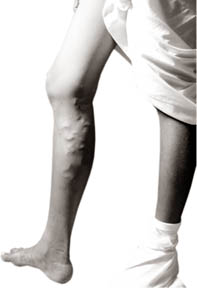|
observer |
|
|
|
|
|
OTHER LINKS |

|

|

|
Knotted veins that cause painVaricose veins could occur in many parts or organs in the body. Varicose veins have affected man probably since we started walking upright. As they are not seen in the legs of even taller animals like the giraffe, bi-pedal gait of man is considered a main risk factor.
Conversely an obese person could have a severe degree of varicose veins, resulting in complications though not at all visible. The lower limb is drained by two main systems of veins the longer running up the inner leg while the shorter vein running posteriorly up to the knee. It is the longer system that is more commonly affected. The commonest feature is the simple varicose veins, they occur more frequently in females. It is not possible to predict which patient will develop complications. However, if one has a strong family history of complicated disease then they may be at a higher risk of developing complications later, and will be better if treated early. Similarly diabetics may be well advised to have their varicose veins treated early due to being more prone to infective complications. Due to pooling of blood in the veins the pressure within them increases. This Venous hypertension results in more serious symptoms such as, swelling, thickening of the skin, itching, discolouration of skin, bleeding and ulceration. If a person develops any of these features it is time to seek professional help. In the early stages, all these features are reversible. However, if skin thickening and pigmentation is well established these may be permanent. In addition to the above features, patients also develop a variety of less serious features such as a heavy feeling of legs, cramps and aching legs. Eczema is also more frequent and less responsive to treatment in patients with varicose veins. Though medically considered less serious, in practise we see some patients suffering disturbances to their daily routine due to the severity of these minor symptoms. In most patients a cause for the varicose veins will not be known. These are termed idiopathic varices, and may possibly be due to a congenital weakness of the veins or their valves. In a minority a cause can be detected such as pregnancy, abdominal tumours, thrombosis of the deep veins (DVT), and congenital malformations of the veins or abnormal communications with the arterial system. These secondary varices should be carefully diagnosed, to select the appropriate mode of treatment. In patients with varices though a clinical examination is mandatory, technical advances now allow a surgeon to scan the entire venous system of the limbs and conclude the cause, site and plan treatment in one sitting. There are four modes of treating varices, conservatively, serotherapy, surgery and laser therapy. Laser is not available in Sri Lanka due to the very high cost. Patients with very small dermal varices (Spider veins) find them cosmetically unacceptable. These can be easily treated by applying make-up to mask them. There are some patients who will not agree for sclerotherapy or surgery. They can be effectively managed conservatively. One has to remember it is the effects of standing that will cause a steady progression of the condition. Therefore, whenever possible try taking the weight off your feet. Sitting is better than standing. Lying down is better than sitting, and keeping the feet elevated is better than lying down. Elevating the foot end of bed by about three inches will also help reduce symptoms. During standing the use of a graduated compression stocking will decrease symptoms appreciably. Sclerotherapy is useful only for varices that originate below the knee. Here the surgeon will inject a sclerosing agent obliterating the veins. In most more than one sitting will be needed to achieve a good result. Surgery when indicated is the gold standard of therapy. Here the entire diseased vein is removed achieving the best cosmetic result with the least recurrence rate. The operation is done as a day procedure under regional or general anaesthesia. The patient returns home the same day and back to work in a couple of days. In Sri Lanka many myths are associated with this operation. Some believe they may be left with a permanent disability or shortening of the leg, others fear they may need the vein for a future coronary bypass. If a permanent disability or shortening of leg occurs then this operation would have been abandoned long ago, also a varicose vein is a diseased vein which is unsuitable for a coronary or any other bypass. In Sri Lanka our patients still present themselves late with long standing ulcers or well established skin changes, due to these unfounded fears. It cannot be emphasised enough that simple treatment will prevent or cure complications of varicose veins. |
 To be termed as varicose, these veins have to be distended, elongated
and hence tortuous. Therefore, veins that are simply visible to the
naked eye, though sometimes considered unsightly are not varicose veins.
These are seen mainly in active young people and are sometimes called
athletes veins.
To be termed as varicose, these veins have to be distended, elongated
and hence tortuous. Therefore, veins that are simply visible to the
naked eye, though sometimes considered unsightly are not varicose veins.
These are seen mainly in active young people and are sometimes called
athletes veins. 






